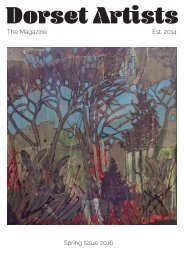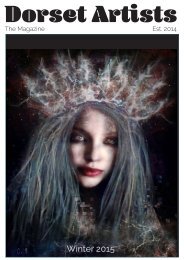Summer 2016 b
Create successful ePaper yourself
Turn your PDF publications into a flip-book with our unique Google optimized e-Paper software.
Andrea Jenkins takes a look at...<br />
The Muse and The Artist:<br />
Camille Claudel<br />
The idea of the muse originates<br />
in Greek mythology,<br />
nine goddesses, daughters of Zeus and<br />
the Titan Mnemosyne (Goddess of memory),<br />
who inspired literature, science and<br />
the arts. Each had an attribute but none is<br />
applied to the visual arts.<br />
The current concept of an artist’s muse<br />
has evolved from this and covers a huge<br />
range of sorts and conditions of people<br />
and other anthropomorphic sources<br />
of inspiration. We tend to think of an<br />
artist’s muse as being model, lover, an<br />
emotional involvement and a fascination<br />
to the artist; often an obsession. This<br />
is particularly the association from the<br />
mid-nineteenth century onwards with the<br />
rise of non-commissioned art and groups<br />
of artists such as the Impressionists and<br />
pre-Raphaelites with shared ideals and<br />
styles … oh and shared muses too!<br />
The muses of the 19th century came from<br />
a variety of backgrounds and several<br />
were well educated, surprisingly liberated<br />
women who were also artists.<br />
One such was Camille Claudel who was<br />
Rodin’s muse for several years in the late<br />
19th century. I was surprised to find that<br />
coming from an ordinary middle class<br />
family she was encouraged in her artistic<br />
talent as a sculptor by her father and was<br />
allowed to study at a women’s art academy<br />
where she was tutored by the sculptor<br />
Alfred Boucher. When he left to work in<br />
Italy, she was introduced to Rodin who<br />
took her as an assistant along with her<br />
fellow student and friend Jessie<br />
Lipscomb.<br />
Her own work, of a neo-classical style, was initially<br />
intimate portraits of family and friends.<br />
She acquired the skills of modelling the human<br />
form which became very useful to Rodin in his<br />
studio. Although Claudel exhibited her sculptures<br />
in the Salon de Paris over the 20 years she<br />
was associated with Rodin, they were always<br />
overshadowed by his monumental creations.<br />
Rodin was was captivated by this beautiful,<br />
precocious nineteen year old who had a passion<br />
for art that equaled his own. She modelled for<br />
him, became his lover and muse but more importantly<br />
became his most prominent assistant<br />
as she helped to compose the huge sculpture<br />
‘The Gates of Hell’ and it is also thought that<br />
she sculpted the hands and feet of the ‘Burghers<br />
of Calais’.<br />
There was mutual inspiration between Claudel<br />
and Rodin during this period and whilst it might<br />
be assumed that the young Claudel would learn<br />
from Rodin as she worked in his studio, there is<br />
evidence that he took ideas from her work also.<br />
Her sculpture of the Girl with the Sheaf is one<br />
example, closely emulated by Rodin’s stone<br />
carving of the same figure.<br />
This relationship combining the professional<br />
and emotional was not smooth and while<br />
Claudel appeared to accept Rodin’s womanising<br />
under the guise of frequently requiring<br />
fresh models for his work, she was more<br />
disturbed by his long term relationship with<br />
Rose Beuret with whom he had a son. Rodin<br />
refused to give up this relationship as Claudel<br />
asked him to constantly and he eventually<br />
married Beuret in 1917, the year they both<br />
died.<br />
Claudel found this love triangle increasingly<br />
difficult to live with and it gradually ate<br />
away at her creativity and sanity. She began<br />
to work obsessively often creating sculptures<br />
that reflected her personal circumstances and<br />
then destroy what she had done. The studio<br />
she eventually rented close to Rodin’s was<br />
her haven and she became more and more of<br />
a recluse living in poverty. She became increasingly<br />
dishevelled, filthy and unpredictable.<br />
her neighbours gave her a wide berth<br />
and warned their children about her. Eventually,<br />
her family realised that she could no<br />
longer care for herself and her brother had<br />
her interned in a mental asylum in 1913 at<br />
the age of 39. That was the end of her career<br />
as a sculptor.<br />
Diagnosed with a persecution complex and<br />
with a paranoia about Rodin, she remained<br />
there until her death in1943. It is a sad story<br />
and I have found a variety of contradictions<br />
while researching her life but most constant<br />
is the description of destruction wrought by<br />
emotional entanglement and perceived betrayal.<br />
It is easy to reflect and wonder why<br />
Claudel let herself be seduced by Rodin,<br />
knowing that he already had a long term partner<br />
and a string of models and mistresses. It<br />
was almost certainly very difficult to live independently<br />
as a female artist at that time,<br />
financially of course, as it still is for any artist,<br />
but also because of social restraints for<br />
women at that time. It is surprising that her<br />
middle class parents allowed her to become<br />
a sculptor at all rather than insisting on the<br />
conventional course of marriage and family<br />
life. Perhaps they thought Rodin would marry<br />
her but that is conjecture.<br />
25 26









